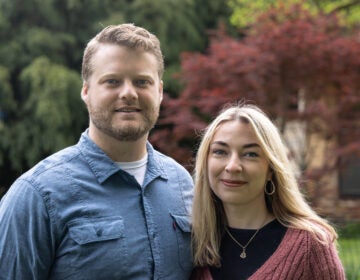Sandra Webberking’s steel menagerie
It was to be yet another strike in an already taxing winter. Meteorologists were predicting a crippling ice storm.
In Springfield, Pa., residents were salting their sidewalks and scraping their windshields.
Artist Sandra Webberking took a different approach. Standing in her driveway, blue bandana in her hair and steel pipe in hand, she assaulted a glassy mound of ice.
This is typical in Webberking’s world, where one day, steel pipes are tools in her winter weather arsenal, the next, they’re the spindly legs of a perching flamingo named Filamina.
For her latest project, a catfish-shaped bike rack for East Falls’ Inn Yard Park, pipes are bent into an eerie, alluring “O”; the open mouth of the freshwater fish.
It’s part of East Falls Development Corporation’s collaborative eco-art project, which project manager Noemi Armstrong says is an effort to “breathe life into the East Falls business district.”
The artwork had to be fish-themed and made of recycled materials, which seemed almost custom-made for Webberking, who specializes in creating fantastical animals, namely birds, with used farm equipment and scrap metal.
Her decorative work can be found at trade shows, home craft stores and even two French restaurants in Media, Pa. Recently, she’s been trying her hand at more functional pieces, like the Frankford Avenue bike racks she’s made for the New Kensington Development Corporation.
They are minimalist, geometric takes on bike spokes and wheels. The rack between Susquehanna and Dauphin Street is fire engine red. It lights up the whole block.
Webberking loves making bike racks. It’s about creating a work of art the city can interact with, art that people don’t put on “some weird pedestal.” She plans on bringing the catfish rack to a trade show in mid-February to gauge interest in her current pursuit. Her dream is to be commissioned to make a whole series of bike racks.
“It would lead me down a completely different path,” she says.
This wouldn’t be the first time Webberking has altered the trajectory of her work. She began at Moore College of Art and Design as a jeweler.
“But one year, I took this horrible class,” she says, wrinkling her nose. It was all about making clasps. “There was such a preciousness about it. With welding, you can just throw what you don’t like in a pile.”
Since then, she’s forsaken clasps for plow blades, antiquated telephone wire insulators and rebar. The grooved rebar, typically used in construction, came in handy for the catfish’s trademark whiskers. The cultipacker was another gem. The circular metal plate, used in farming machinery to crush dirt clods, made the perfect oversized catfish eye.
She sources her materials from a long list of contacts: the tractor supply store that holds onto used equipment for her, the antiques collector and the Amish farmers.
Though she works with sullied and jagged metals, there is a freshness and polish to her art. A dinnertime candelabra wrought from telephone line insulators and a car respirator seems at home next to little potted succulents in her sunlit kitchen. At first glance, it’s unthinkable that the candle holders were once a mundane, electrician’s tool. And that’s exactly how Webberking wants it.
She works out of a converted garage that looks more like a factory than a studio. In the first room, there lives a steel menagerie: a maze of rusted, lacquered peacocks with marbles glinting in their feathers and regal flamingos that tower over Webberking herself. The next – “the disaster room,” she calls it, houses her welder, her hydraulic pipe bender, a handheld metal grinder and green and yellow tanks of oxygen and acetylene for welding. Wavy pipe climbs across the walls, while heavy jars of marbles sit huddled on a table. This is where her pieces come together.
Amid all of the rubble is the giant catfish. Mouth open, rebar whiskers curled, the creature flails to life in simple, curved lines. Webberking admits he’s a little creepy, as catfish are in real life, but thinks there’s also something friendly about him.
After being powder-coated an aquatic blue-green, he’ll take residency at Inn Yard Park at the end of the month. Park patrons can chain their bikes to nearly any part of the fish.
“Hopefully it’ll make them smile,” she says.
To learn more about Webberking’s work, visit sandrawebberking.com.
WHYY is your source for fact-based, in-depth journalism and information. As a nonprofit organization, we rely on financial support from readers like you. Please give today.




